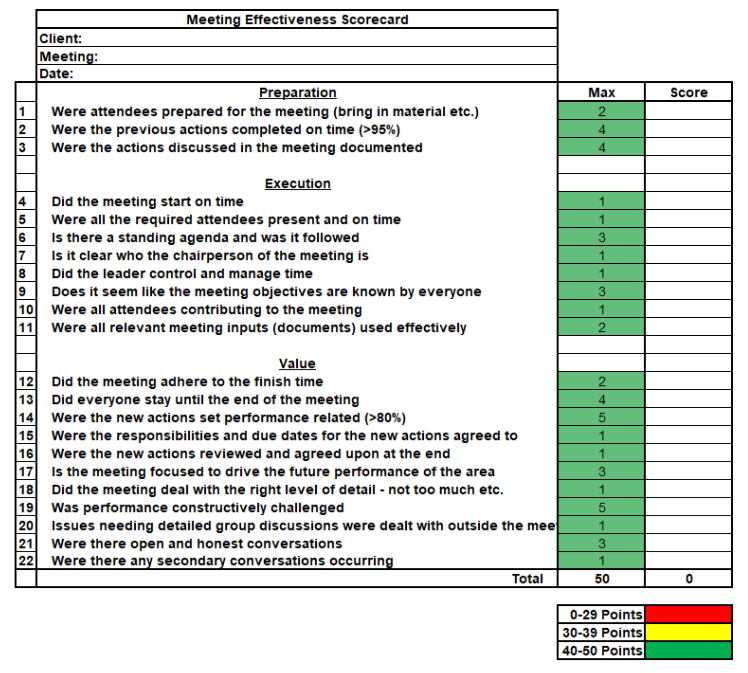As the pioneers of operational excellence through behavior based change management, we are frequently asked by our prospects “What constitutes an effective meeting?.” Regardless of the industry or size of the company, we consistently find that ineffective meetings are one of the largest productivity losses. Not only do ineffective meetings suck up a lot of the time of many, they have the ability to create action items that are not in line with the short, medium, and long-term goals of the business. As such, ineffective meetings are not only considered time robbers, they are also extractors of a lot of brain power and people’s energy which can deter potential clients and employees from engaging on the things that truly matter for the existence of your business. More importantly, ineffective meetings miss the opportunity to bring teams and clients closer together. In the world where people and communities are connected virtually, it’s that much more important to bring teams together through effective meetings.
Today businesses are challenged with not only conducting effective internal meetings, they must also communicate effectively, internal and externally, amidst the social distancing requirements being imposed on our normal ways of communicating.
What should New Normal look like when trying to communicate, whether on-line or in a group setting?
At the outset of all our operational transformation projects, and to truly understand the internal issues creating blockages within a firm, we inevitably look at the strength of a company’s current internal communications. From front-line management and above, most businesses have a set of standing meetings on everyone’s weekly agendas, ranging from informal discussions to more formal meetings; these are intended to facilitate communication within the organization. Our results typically show that 60% of meetings are highly ineffective as they don’t have the right audience, decision makers, follow an agenda that is linked to performance indicators, or fail to establish continuity to action items to better the performance of a business.
Now, with the current remote working scenario, not only has meeting volume increased, meeting audience has expanded. Based on our engagement with over 1 million business leaders over 74 years, we estimate that ineffective meetings could have risen by an additional 20%. Now, more than ever company meetings, should be correctly structuring all meetings and ensuring their effectiveness; this will be key for competitive advantage in keeping all company employees engaged and sustaining valuable conversations in and outside of the organization.
There are four different types of meetings: Information Sharing, Planning, Problem Solving and Performance review. Each of these can be more effective and improve productivity if they focus on the following three elements:
- Preparation
- Execution
- Value
While these may seem simple terms, the three meeting elements are composed of a series of sub-elements to make them successful.
Components of each of the successful meeting elements
Preparation.
As with all activities, the more time spent preparing for success, the more likely you are to achieve a successful outcome. Asking yourself the following will improve your meeting preparations:
- How well prepared am I for the meeting?
- Was an agenda prepared and distributed before the meeting?
- Was the objective of the meeting made clear to all attendees when the agenda was distributed?
- Were all participants informed of what preparation was required for the meeting and their role in the meeting?
In our experience, meetings without the right level of preparation from meeting participants end up taking a hit on execution as they typically are highjacked by topics that were not intended as part of the meeting; generally these are topics that participants prepared for as the agenda or objective of the meeting was not clear.
Execution.
“If you show up on time, … you are late!” Proper time management improves productivity across the organization. Asking yourself the following will during or after the meeting will improve your meeting execution:
- Did the meeting start on time?
- Were the people you invited in attendance?
- Is there a standing agenda, and was it followed?
- Were all attendees contributing to the meeting?
- Did the leader control the meeting flow and manage the time allotment?
- If you are leading the meeting, did you observe if attendees were prepared for the meeting? (i.e. bringing in materials etc.) and did you invite the right people to participate?
- Did all required attendees or delegates support the meeting?
- Were the past actions completed?
- Were these actions discussed and documented?
Highly effective meetings will have positive answers to the questions above. If the answer is no, then, in most cases, the meeting not only didn’t execute properly, it most likely didn’t provide the maximum value to the meeting participants and didn’t not further contribute to the long-term objectives of the meeting itself.
Value
The value of a meeting, like anything else that is meant to drive meaningful results, can and should be measured by many barometers. Some value gauging questions to consider are:
- Did you adhere to your time contract, and did everyone stay until the end of the meeting?
- Were the newly agreed upon performance related actions?
- Did the meeting deal with the right level of detail?
- Were there open and honest conversations, including constructively challenging ones?
Reflect upon recent meetings you have attended. In answering the questions above, how did the meeting fair? Often when evaluating client meetings we find opportunities to improve the overall effective communication of the meeting, pre and post meeting. By taking a unbiased view of a meeting, organizations have the opportunity to better communicate meeting outcomes, actions, and company direction.
How effective are you and how effective is your organization in communicating?
The below, is a Proudfoot tool we use to score meeting effectiveness. We invite you to use it to evaluate and improve the effectiveness of your own meetings, remembering that highly effective meetings have the ability to engage your workforce, increase productive time, raise time allotted to deep thinking, and bring your teams together.
Try working some of these ideas into your upcoming meetings. By model the behaviors associated with effective meetings and progress will begin to happen. When you sustain certain communications practices over time, (some alluded by the effectiveness of your meetings), your organization is better prepared to achieve and sustain a higher level of performance.
As many leaders in the organization have been forced to conduct business remotely, the critical discipline in following the guidelines above is imperative to keep entire workforces engaged and productive during a downtime period. These guidelines will ensure full participation, the achievement of the objectives of meetings, and ensure the correct information is circulating in the remote workplace. Effective Meetings, remote or in-person, that involve the right participants can have a positive influence on moral and create a positive culture. The opposite is also true if ineffective meetings.
Lastly, using video is always the best option when conducting remote meetings. teams get to see everyone’s engagement, examine gestures, tone of voice, general attitude, and feel more included and part of a community. In this situation the participants will generally be better prepared and have a moral boost by having that visual contact to show they are not alone.
Call or email us on the success of some of these ideas. We will publish them in upcoming blog articles. We would be happy to hear about your results and share more on this topic.


